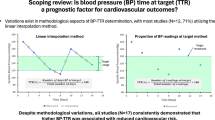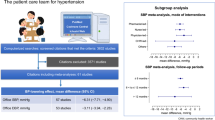Abstract
The Horoscope trial aimed to assess the efficacy of home blood pressure (BP) telemonitoring (TLM) in controlling BP reduction in hypertensive patients compared with usual care. This is a multi-center, prospective randomized, parallel-group trial comparing TLM with usual care during a period of 6 months in patients with hypertension. We included 525 patients randomly assigned in a 1-1 ratio to telemonitoring (TLM group; n = 260) or usual care (control group; n = 265). After 6 months of follow up, mean values of 24-h systolic and diastolic blood pressure decreased in both TLM and control groups. The mean decrease was significantly greater in the TLM group vs control group (−3.29 mmHg Vs −1.19; p = 0.009) and (−2.9 mmHg Vs, −0.07; p = 0.002) for systolic and diastolic blood pressure, respectively. This study shows that TLM results in significant BP reduction compared to usual care in a Tunisian population of patients with hypertension. Our findings highlight the importance of integrating telemedicine in the management of hypertensive patients; it has the potential to improve the quality of the delivered care and to prevent cardiovascular consequences of uncontrolled BP.

This is a preview of subscription content, access via your institution
Access options
Subscribe to this journal
Receive 12 print issues and online access
$259.00 per year
only $21.58 per issue
Buy this article
- Purchase on SpringerLink
- Instant access to full article PDF
Prices may be subject to local taxes which are calculated during checkout



Similar content being viewed by others

References
Lim SS, Vos T, Flaxman AD, Danaei G, Shibuya K, Adair-Rohani H, et al. A comparative risk assessment of burden of disease and injury attributable to 67 risk factors and risk factor clusters in 21 regions, 1990–2010: a systematic analysis for the Global Burden of Disease Study. Lancet. 2010;380:2224–60.
Dai H, Bragazzi NL, Younis A, Zhong W, Liu X, Wu J, et al. Worldwide trends in prevalence, mortality, and disability-adjusted life years for hypertensive heart disease from 1990 to 2017. Hypertension. 2021;77:1223–33.
Liu J, Bu X, Wei L, Wang X, Lai L, Dong C, et al. Global burden of cardiovascular diseases attributable to hypertension in young adults from 1990 to 2019. J Hypertens. 2021;39:2488–96.
Nguyen TN, Chow CK. Global and national high blood pressure burden and control. Lancet. 2021;398:932–3.
Falaschetti E, Mindell J, Knott C, Poulter N. Hypertension management in England: a serial cross-sectional study from 1994 to 2011. Lancet. 2014;383:1912–9.
Chow CK, Teo KK, Rangarajan S, Islam S, Gupta R, Avezum A, et al. Prevalence, awareness, treatment, and control of hypertension in rural and urban communities in high-, middle-, and low-income countries. JAMA. 2013;310:959–68.
McManus RJ, Mant J, Haque MS, Bray EP, Bryan S, Greenfield SM, et al. Effect of self-monitoring and medication self-titration on systolic blood pressure in hypertensive patients at high risk of cardiovascular disease: the TASMIN-SR randomised clinical trial. JAMA. 2014;312:799–808.
Tucker KL, Sheppard JP, Stevens R, Bosworth HB, Bove A, Bray EP, et al. Self-monitoring of blood pressure in hypertension: a systematic review and individual patient data meta-analysis. PLoS Med. 2017;14:e1002389.
McKinstry B, Hanley J, Wild S, Pagliari C, Paterson M, Lewis S, et al. Telemonitoring based service redesign for the management of uncontrolled hypertension: multicentre randomised controlled trial. BMJ. 2013;346:f3030.
McManus RJ, Mant J, Franssen M, Nickless A, Schwartz C, Hodgkinson J, et al. Efficacy of self-monitored blood pressure, with or without telemonitoring, for titration of antihypertensive medication (TASMINH4): an unmasked randomised controlled trial. Lancet. 2018;391:949–59.
Monahan M, Jowett S, Nickless A, Franssen M, Grant S, Greenfield S, et al. Cost-effectiveness of telemonitoring and self-monitoring of blood pressure for antihypertensive titration in primary care (TASMINH4). Hypertension. 2019;73:1231–9.
Ben Romdhane H, Ben Ali S, Skhiri H, Traissac P, Bougatef S, Maire B, et al. Hypertension among Tunisian adults: results of the TAHINA project. Hypertens Res. 2012;35:341–7.
Ben Hafaiedh S, Ben Daya Y, Radoui AH, Bouchoucha M, Razgallah R, Nouira S. Home telemonitoring of arterial hypertension with antihypertensive treatment titration: protocol for a randomised controlled prospective trial (HOROSCOPE study). JMIR Res Protoc. 2022;11:e26184.
Ware J, Kosinski M, Keller SD. A 12-item short-form health survey: construction of scales and preliminary tests of reliability and validity. Med Care. 1996;34:220–33.
Yin R, Yin L, Li L, Silva-Nash J, Tan J, Pan Z, et al. Hypertension in China: burdens, guidelines and policy responses: a state-of-the-art review. J Hum Hypertens. 2022;36:126–34.
Kearney PM, Whelton M, Reynolds K, Muntner P, Whelton PK, He J. Global burden of hypertension: analysis of worldwide data. Lancet. 2005;365:217–23.
Liu M, Li Y, Wei FF, Zhang L, Han JL, Wang JG. Is blood pressure load associated, independently of blood pressure level, with target organ damage? J Hypertens. 2013;31:1812–8.
Bloomfield D, Park A. Night time blood pressure dip. World J Cardiol. 2015;7:373–6.
Christensen JKB. The emergence and unfolding of telemonitoring practices in different healthcare organizations. Int J Environ Res Public Health. 2018;15:61.
Katz ME, Mszar R, Grimshaw AA, Gunderson CG, Onuma OK, Lu Y, et al. Digital health interventions for hypertension management in US populations experiencing health disparities: a systematic review and meta-analysis. JAMA Netw Open. 2024;7:e2356070.
Meng WW, Bai YY, Yan L, Zheng W, Zeng Q, Zheng YS, et al. Effect of home blood pressure telemonitoring plus additional support on blood pressure control: a randomised clinical trial. Biomed Environ Sci. 2023;36:517–26.
McManus RJ, Little P, Stuart B, Morton K, Raftery J, Kelly J, et al. Home and online management and evaluation of blood pressure (HOME BP) using a digital intervention in poorly controlled hypertension: randomised controlled trial. BMJ. 2021;372:m4858.
Park SH, Shin JH, Park J, Choi WS. An updated meta-analysis of remote blood pressure monitoring in urban-dwelling patients with hypertension. Int J Environ Res Public Health. 2021;18:10583.
Rahimi K, Bidel Z, Nazarzadeh M, Copland E, Canoy D, Wamil M, et al. Age-stratified and blood-pressure-stratified effects of blood-pressure-lowering pharmacotherapy for the prevention of cardiovascular disease and death: an individual participant-level data meta-analysis. Lancet. 2021;398:1053–64.
Banegas JR, Ruilope LM, de la Sierra A, Vinyoles E, Gorostidi M, de la Cruz JJ, et al. Relationship between clinic and ambulatory blood-pressure measurements and mortality. N. Engl J Med. 2020;378:1509–20.
AbuDagga A, Resnick HE, Alwan M. Impact of blood pressure telemonitoring on hypertension outcomes: a literature review. Telemed J E Health. 2010;16:830–8.
Sin DYE, Guo X, Yong DWW, Qiu TY, Moey P, Falk MR, et al. Assessment of willingness to Tele-monitoring interventions in patients with type 2 diabetes and/or hypertension in the public primary healthcare setting. BMC Med Inf Decis Mak. 2020;20:11.
Acknowledgements
The study was funded by the Medis Laboratories. Medis Laboratories provided supplies of home blood pressure monitors and supported the trial with an additional grant. We also thank all the participants, physicians, nurses, and other staff who contributed to the HOROSCOPE study.
HOROSCOPE study group
Nawel Belkacem11, Marouen Hafsa12, Sami Zayene13, Mounira Sahtout14, Lotfi Ghedira15, Hajer Yaakoubi5, Sonia Khedher16, Anis Gtari15, Moncef Chebil13, Sami Ben Said15, Fahima Hassine15, Olfa Harzallah17, Faten Saadallah15, Meniar Saafi1, Khaoula Bel Haj Ali1,2, Randa Dhaoui1,2, Marwa Toumia3, Sarra Sassi1,2, Yosra Bendaya4, Mohamed Bouchoucha4, Sonia Ben Hafaeidh4, Imen Trabelsi1, Adel Sekma1,2, Rahma Jaballah5, Hajer Yaakoubi5, Rym Youssef5, Asma Zorgati5, Kaouthar Beltaief1,2, Zied Mezgar6, Mariem Khrouf6, Amira ghaier7, Nahla Jerbi7, Rabie Razgallah8, Wahid Bouida1,2, Mohamed Habib Grissa1,2, Jamel Saad9, Hamdi Boubaker1,2, Zohra Dridi10, Riadh Boukef1,5, Mohamed Amine Msolli1,2, Semir Nouira1,2
Funding
Ministry of Higher Education and Scientific Research and Medis Laboratories.
Author information
Authors and Affiliations
Consortia
Corresponding author
Ethics declarations
Conflict of interest
The authors declare no competing interests.
Additional information
Publisher’s note Springer Nature remains neutral with regard to jurisdictional claims in published maps and institutional affiliations.
Rights and permissions
Springer Nature or its licensor (e.g. a society or other partner) holds exclusive rights to this article under a publishing agreement with the author(s) or other rightsholder(s); author self-archiving of the accepted manuscript version of this article is solely governed by the terms of such publishing agreement and applicable law.
About this article
Cite this article
Saafi, M., Bel Haj Ali, K., Dhaoui, R. et al. Phone-based telemonitoring of arterial hypertension versus usual care: the HOROSCOPE study. Hypertens Res 48, 1135–1143 (2025). https://doi.org/10.1038/s41440-024-02018-6
Received:
Revised:
Accepted:
Published:
Issue date:
DOI: https://doi.org/10.1038/s41440-024-02018-6


